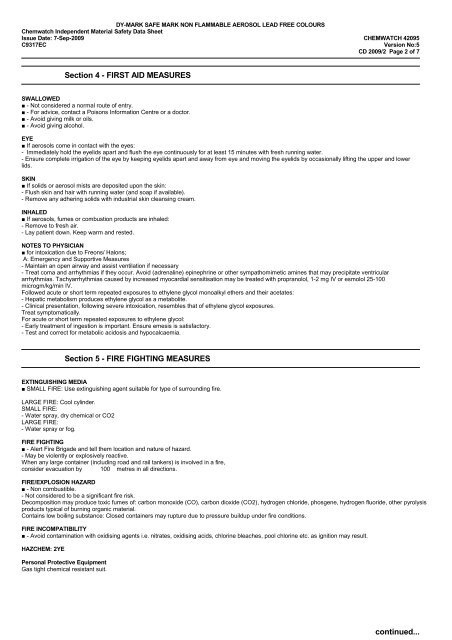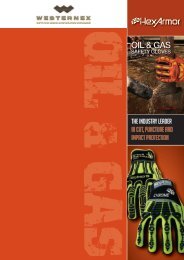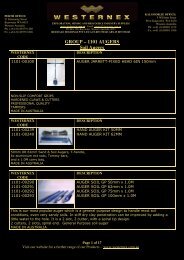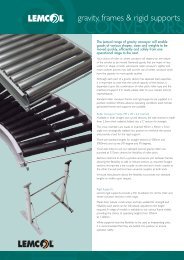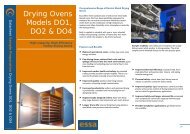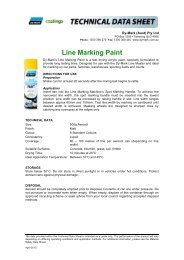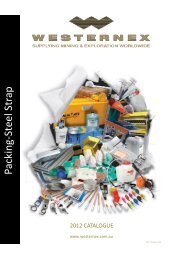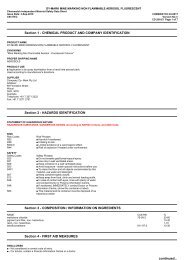Chemwatch Australian MSDS 42095 - Westernex
Chemwatch Australian MSDS 42095 - Westernex
Chemwatch Australian MSDS 42095 - Westernex
You also want an ePaper? Increase the reach of your titles
YUMPU automatically turns print PDFs into web optimized ePapers that Google loves.
DY-MARK SAFE MARK NON FLAMMABLE AEROSOL LEAD FREE COLOURS<br />
<strong>Chemwatch</strong> Independent Material Safety Data Sheet<br />
Issue Date: 7-Sep-2009 CHEMWATCH <strong>42095</strong><br />
C9317EC<br />
Version No:5<br />
CD 2009/2 Page 2 of 7<br />
Section 4 - FIRST AID MEASURES<br />
SWALLOWED<br />
■ - Not considered a normal route of entry.<br />
■ - For advice, contact a Poisons Information Centre or a doctor.<br />
■ - Avoid giving milk or oils.<br />
■ - Avoid giving alcohol.<br />
EYE<br />
■ If aerosols come in contact with the eyes:<br />
- Immediately hold the eyelids apart and flush the eye continuously for at least 15 minutes with fresh running water.<br />
- Ensure complete irrigation of the eye by keeping eyelids apart and away from eye and moving the eyelids by occasionally lifting the upper and lower<br />
lids.<br />
SKIN<br />
■ If solids or aerosol mists are deposited upon the skin:<br />
- Flush skin and hair with running water (and soap if available).<br />
- Remove any adhering solids with industrial skin cleansing cream.<br />
INHALED<br />
■ If aerosols, fumes or combustion products are inhaled:<br />
- Remove to fresh air.<br />
- Lay patient down. Keep warm and rested.<br />
NOTES TO PHYSICIAN<br />
■ for intoxication due to Freons/ Halons;<br />
A: Emergency and Supportive Measures<br />
- Maintain an open airway and assist ventilation if necessary<br />
- Treat coma and arrhythmias if they occur. Avoid (adrenaline) epinephrine or other sympathomimetic amines that may precipitate ventricular<br />
arrhythmias. Tachyarrhythmias caused by increased myocardial sensitisation may be treated with propranolol, 1-2 mg IV or esmolol 25-100<br />
microgm/kg/min IV.<br />
Followed acute or short term repeated exposures to ethylene glycol monoalkyl ethers and their acetates:<br />
- Hepatic metabolism produces ethylene glycol as a metabolite.<br />
- Clinical presentation, following severe intoxication, resembles that of ethylene glycol exposures.<br />
Treat symptomatically.<br />
For acute or short term repeated exposures to ethylene glycol:<br />
- Early treatment of ingestion is important. Ensure emesis is satisfactory.<br />
- Test and correct for metabolic acidosis and hypocalcaemia.<br />
Section 5 - FIRE FIGHTING MEASURES<br />
EXTINGUISHING MEDIA<br />
■ SMALL FIRE: Use extinguishing agent suitable for type of surrounding fire.<br />
LARGE FIRE: Cool cylinder.<br />
SMALL FIRE:<br />
- Water spray, dry chemical or CO2<br />
LARGE FIRE:<br />
- Water spray or fog.<br />
FIRE FIGHTING<br />
■ - Alert Fire Brigade and tell them location and nature of hazard.<br />
- May be violently or explosively reactive.<br />
When any large container (including road and rail tankers) is involved in a fire,<br />
consider evacuation by 100 metres in all directions.<br />
FIRE/EXPLOSION HAZARD<br />
■ - Non combustible.<br />
- Not considered to be a significant fire risk.<br />
Decomposition may produce toxic fumes of: carbon monoxide (CO), carbon dioxide (CO2), hydrogen chloride, phosgene, hydrogen fluoride, other pyrolysis<br />
products typical of burning organic material.<br />
Contains low boiling substance: Closed containers may rupture due to pressure buildup under fire conditions.<br />
FIRE INCOMPATIBILITY<br />
■ - Avoid contamination with oxidising agents i.e. nitrates, oxidising acids, chlorine bleaches, pool chlorine etc. as ignition may result.<br />
HAZCHEM: 2YE<br />
Personal Protective Equipment<br />
Gas tight chemical resistant suit.<br />
continued...


